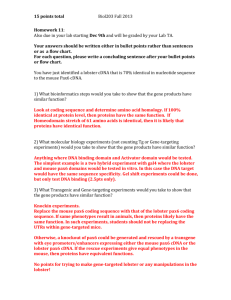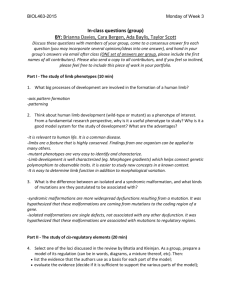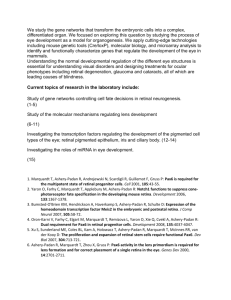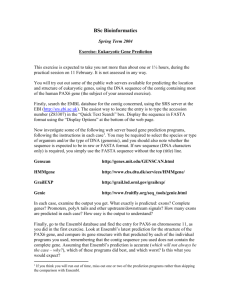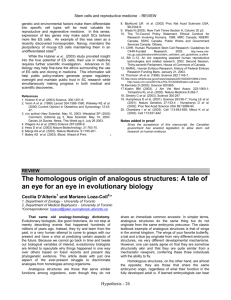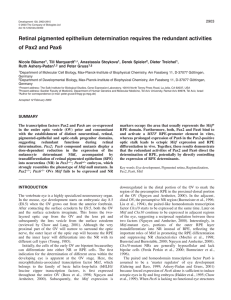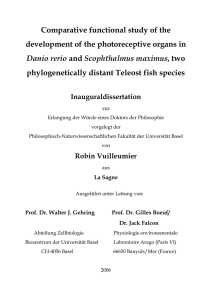NN-A43409A Supplementary Material for: Sensory cortex limits
advertisement
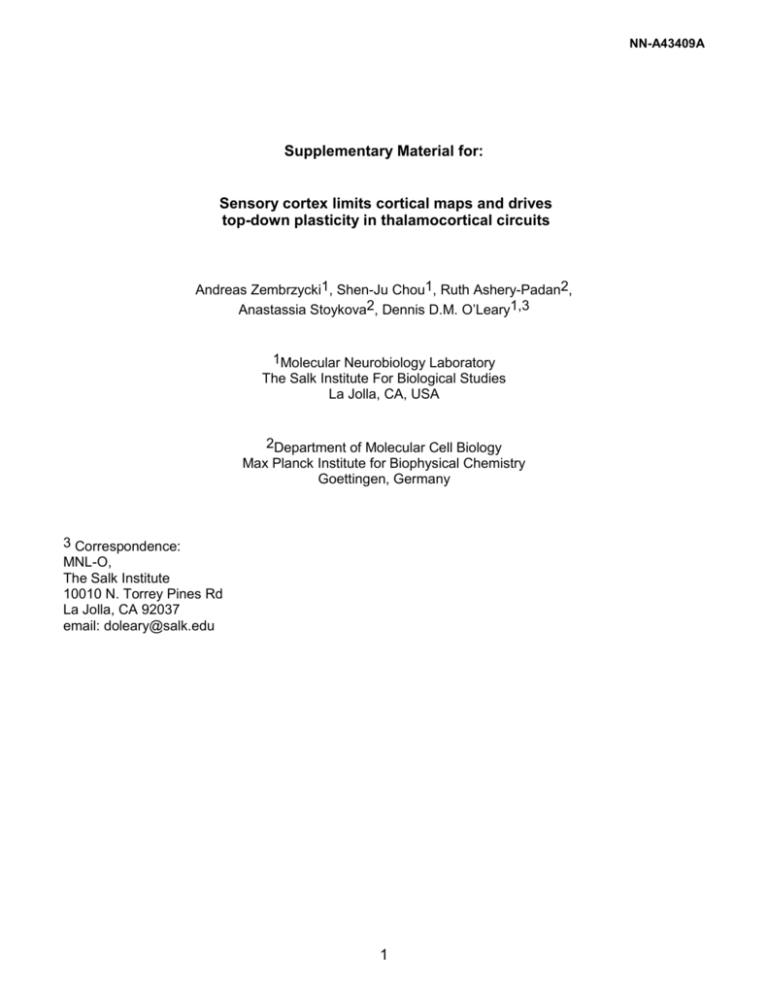
NN-A43409A Supplementary Material for: Sensory cortex limits cortical maps and drives top-down plasticity in thalamocortical circuits Andreas Zembrzycki1, Shen-Ju Chou1, Ruth Ashery-Padan2, Anastassia Stoykova2, Dennis D.M. O’Leary1,3 1Molecular Neurobiology Laboratory The Salk Institute For Biological Studies La Jolla, CA, USA 2Department of Molecular Cell Biology Max Planck Institute for Biophysical Chemistry Goettingen, Germany 3 Correspondence: MNL-O, The Salk Institute 10010 N. Torrey Pines Rd La Jolla, CA 92037 email: doleary@salk.edu 1 NN-A43409A Supplementary Figure 1. The mouse somatosensory system with a focus on the trigeminal “periphery to cortex” pathway. Sensory information from sensory receptors surrounding the follicles of the big motile facial whiskers (for simplicity the four straddler barrels are ignored) and smaller sinus hairs on the mouse face is transferred through hindbrain, thalamus and neocortex, where the sensory information is brought to perception in the primary somatosensory area (S1). Each of these structures has a somatotopic map of the primary body representations. a: Neurons whose cell bodies reside in the trigeminal ganglion form the trigeminal nerve and infraorbital nerve that innervates the different regions of the mouse face ipsilaterally, including the five rows of whisker follicles ‘A’ to ‘E’ (represented in PMBSF), the lower jaw (LJ) and the nose area and small whiskers on the upper lip (represented in ALBSF) through distinct nerve branches. b: These nerve branches transmit sensory information from the face to the hindbrain where they form a somatotopic map of the whiskers and the rest of the face and body in the rostral principal nucleus (PrV) and the caudal spinal nucleus (SpV, not indicated for simplicity). Although the point-to-point somatotopic map is faithfully retained, the orientation of the barrelette map in the hindbrain is inverted relative to the orientation of the facial whiskers and rest of the body map. c: Trigeminothalamic axons from the PrV and SpV cross the midline of the brain and project to the contralateral sensory thalamus to innervate the ventroposterior nucleus (VPN) of thalamus. In VPN, the orientation of the maps of facial whisker rows and other primary body representations switch their orientation again to form the thalamic barreloid map. d: Thalamocortical axons (TCAs) from VPN travel through the internal capsule and ventral forebrain to enter the neocortex and innervate S1. TCAs from the medial subdivision of VPN form the stereotypic whisker-related barrels in PMBSF located posteriorly in S1. TCAs from the lateral subdivision of VPN form the remainder of the body representations in more anterior and medial S1, including ALBSF, LJ, forepaw (FP), hindpaw (HP) and trunk (T). Abbreviations: ALBSF, anterior lateral barrel subfield; LD, laterodorsal thalamic nucleus; LP, lateral posterior thalamic nucleus; PMBSF, posterior medial barrel subfield; Po, posterior thalamic nuclear group; VL, ventrolateral thalamic nucleus; VM, ventromedial thalamic nucleus; Rt, reticular nucleus; ic, internal capsule; Su5, supratrigeminal nucleus; 5N, trigeminal-solitary transition zone. 2 NN-A43409A Supplementary Figure 2. Summary of main findings. Illustrated are the mature body maps in S1 cortex and VPN thalamus of wildtype (WT) and mice with a cortex-specific deletion of Pax6 from cortical progenitors (cKO). Our main findings schematized in the panels include: (a) Cortex-specific deletion of Pax6 reduces S1 size indicating that Pax6 specifies S1 area identity in cortical progenitors; reduction of S1 size results in a miniaturization of all primary representations in the S1 body map to varying degrees (e.g. in cKO S1, ALBSF was only 14% of wildtype size whereas PMBSF was 37%), and the reproducible loss of selective representations in the S1 body map, e.g. PMBSF row ‘A’ and most barrels in ALBSF. (b) The changes in S1 engage a retrograde, top-down plasticity that re-patterns an initially normal VPN through an exaggerated selective apoptosis focused in regions of VPN representing body representations deleted from S1. Thalamocortical axons (TCAs) relay sensory information from VPN to S1 for specific body representations (blue lines in left panel in b); subsets of TCAs are excluded from the reduced S1 in cKO mice resulting in their elimination (dotted red lines in right panel in b) and the retrograde loss of their parent VPN neurons through apoptosis (red domains in VPN). (c) This top-down plasticity matches both the size of VPN and its body map to the reduced size of S1 and its incomplete body map. Other studies presented in the paper but not summarized here indicate that competitive interactions between TCAs from VPN drive the processes depicted here. Abbreviations: A, anterior; ALBSF, anterolateral barrel subfield; D, dorsal; FP, forepaw; HP, hindpaw; L, lateral; LJ, lower jaw; M, medial; P, posterior; PMBSF, posteromedial barrel subfield; T, trunk V, ventral. 3 NN-A43409A Supplementary Figure 3. Identification of PMBSF barrel row absent from S1 of Pax6 cKO. Sensory deprivation by lesion of ‘C’ row whisker follicles at PND1 results in bottom-up plasticity and fusion of the PMBSF barrel row ‘C’ in S1, as demonstrated by 5HT staining on flattened sections at PND7 (white arrows a). The location of the fused ‘C’ row in cKO PMBSF (white arrows b) confirms that the caudalmost barrel row ‘A’ is absent from the PMBSF representation in S1 of Pax6 cKO mice. Scale bar in a, 250µm. Supplementary Figure 4. ROR-IRES-Cre mediated recombination enables permanent and reproducible genetic labeling of TCAs. GFP immunostaining of sagittal sections through the brain of ROR-IRES-Cre; ROSA26-GAP43-eGFP mice at PND0 identifies robust recombination and reporter activation in cells of each of the three principal sensory thalamic nuclei (dLGN, VPN, MGN), selectively induced by the ROR-IRES-Cre line beginning around E14.5. Membrane-tagged GAP43-eGFP reporter labels TCAs traversing through the internal capsule (arrow) as well as invading into layer 4 of S1. ROR-IRES-Cre mediated recombination is not detected in cortical cells (also see Chou et al. 2013). Abbreviations: D, dorsal; dLGN, dorsal lateral geniculate nucleus; MGN, medial geniculate nucleus; P, posterior; TCAs, thalamocortical axons; VPN, ventroposterior nucleus; V1, primary visual area. Scale bar, 200µm. 4 NN-A43409A Supplementary Figure 5. Generation of conditional Pax6 transgenic mice and cortex-specific Pax6 transgene activation using Emx1-IRES-Cre. a: Schematic of transgene expression construct and Emx1-IRESCre recombined expression construct. Cre-recombination removes the eGFP reporter cassette including the STOP cassette between the LoxP sites (flox) enabling expression of the downstream Pax6 cDNA (see also Online Methods). Cre recombination driven by the Emx1-IRES-Cre transgene in cKO; cTG mice eliminates endogenous floxed Pax6 alleles and simultaneously expresses ectopic Pax6 from the transgene (lower cartoon a). b: PCR genotyping of five embryos from the Nestin-Pax6 TG (cTG) crossed with Emx1-IRES-Cre. Genotyping identifies that Embryos 2 and 4 are positive for the transgene (TG) but Cre negative, while Embryos 1, 3 and 5 are both TG positive and Cre positive. With HSP (heat shock promoter element) and Pax6 primers, the PCR products reveal the correct recombination in embryos 1, 3 and 5. c: Coronal sections of E13.5 cTG brains. Left top panel: eGFP expression in progenitors in the cortical ventricular zone (VZ) and ganglionic eminence (GE) demonstrates that the eGFP reporter and the floxed STOP cassette are intact. Left bottom panel: On an adjacent section, ISH for Pax6 reveals normal graded expression in cortical progenitors in VZ. Right top panel: cTG embryos that are Emx1-IRESCre positive have the STOP cassette selectively deleted from neocortex (CTX) shown by loss of eGFP expression in cortex but its retention in the ganglionic eminence. On an adjacent section, Pax6 transgene activation is evident selectively in cortical VZ progenitors resulting in a substantial increase in Pax6 expression in cortical progenitors, keeping its normal high to low, lateral (L) to medial (M) gradient. Abbreviation: CP, cortical plate. Scale bar in c, 0.5mm. 5 NN-A43409A Supplementary Figure 6. Cortex-specific expression of Pax6 transgene partially rescues the reduction in S1 size in Pax6 cKO. Tangential sections through flattened cortex of PND7 mice were immunostained for serotonin (5HT) to reveal the PMBSF representation in S1 (outlined in a - d) . Compared to WT (a), in brains in which the conditional Pax6 transgene is activated in cortical progenitors by Emx1-IRES-Cre (cTG), the size and location of the PMBSF is indistinguishable. In cKO mice (generated by crossing floxed Pax6 mice to the Emx1-IRES-Cre line), PMBSF is significantly reduced. In contrast, Pax6 cKO brains with an activated conditional Pax6 transgene (cKO; cTG; with both deletion of the floxed Pax6 and activation of the Pax6 transgene done simultaneously in the same cortical progenitors with Emx1-IRES-Cre) have significant increase (~23%) in size of PMBSF. (e) The measured size of PMBSF in WT is set at 100%, and other genotypes are expressed as a percentage of the WT size. PMBSF size in cTG (98.12% +/– 3.62%, p = 0.3687, t = 0.97, df = 6, n = 5) does not differ significantly from WT. Conversely, compared to PMBSF size in cKO mice (60.8% +/– 11.23% of WT, n = 5), PMBSF size in the cKO; cTG mice is significantly larger (74.8% +/– 8.91% of WT, p = 0.0004, t = 4.91, df = 12, n = 6). N = # of brains analyzed per genotype. Scale bar in a, 0.5mm. 6
